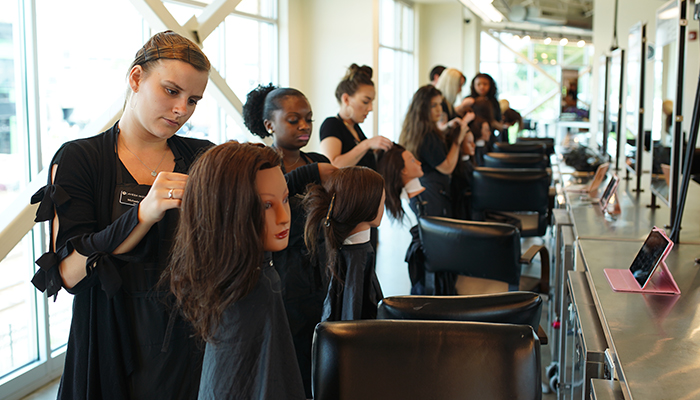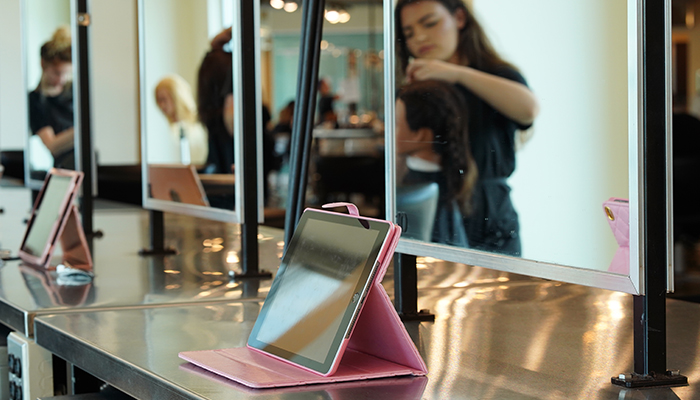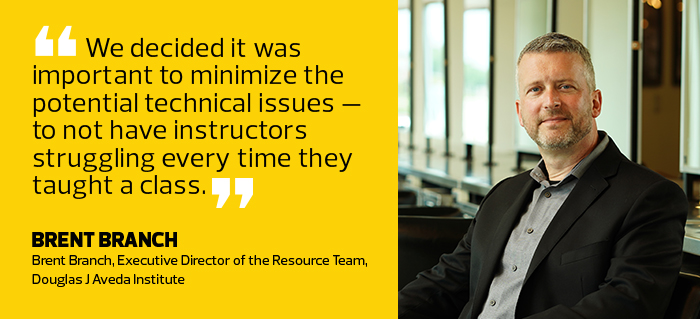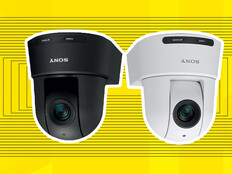One to One Computing Graduates from K–12 to Higher Education
Students of cosmetology traditionally start classes armed with their own professional kit containing scissors, brushes and hair dryers, among other items. At one institution, students also have a new tool of the trade: a 9.7-inch, 32-gigabyte iPad device.
Douglas J Aveda Institute, which provides vocational training in cosmetology and esthiology at six campuses in Illinois, Michigan and Tennessee, has included iPads in student kits for the past three years, says Brent Branch, executive director of the resource team. Students purchase a professional kit, including the iPad, when they start the program.
“We rely on a learning management system, and we use the iPads to deliver the curriculum in a standardized way,” Branch says. The tablets also support students as they gain hands-on experience. For example, an instructor might demonstrate a new cutting technique before asking students to practice it themselves on their mannequins. “
As they work, they’ll have their iPads right there with a video of the cut they can reference as they need to,” says Branch.
SIGN UP: Get more news from the EdTech newsletter in your inbox every two weeks!
Standardize Student Devices to Simplify Tech Support
Putting all students on the same technology with a one-to-one strategy was far preferable to the alternative, Branch says. “We could have allowed everyone to bring whatever device they wanted, but we decided it was important to minimize the potential technical issues — to not have instructors struggling every time they taught a class.”
To get Douglas J’s program up and running, the only back-end work required was an upgrade to the institute’s wireless infrastructure. “We put new Cisco gear in every classroom, and it’s been relatively smooth sailing ever since,” Branch says.
One-to-one programs have been much more common in K–12 settings, but in recent years, they have been gaining ground in higher education. A variety of institutions have embraced their own versions, handing out iPads, Chromebooks and other devices to students to enhance the learning experience in their increasingly digital classrooms.

Students at the Douglas J Aveda Institute combine personal devices with mannequins to perfect their styling techniques. Photo: Nick Hagen
“The advantages of one-to-one have mostly to do with consistency,” says Elliot Soloway, a computer science professor at the University of Michigan who studies educational technologies. “When teachers know what devices their students are going to show up with, they also know what technologies they can use that will work with them. That lets them plan their lessons appropriately.”
In the typical BYOD classroom, on the other hand, there’s no telling what an instructor might face. “There’s tremendous variability, and that can be really tough on teachers,” Soloway says.
Device Specifications Allow for Flexibility and Maintain Efficiency
Not long ago, variability was an issue at MIAT College of Technology, a Michigan-based vocational college providing training in fields such as aviation maintenance and wind tower construction. In 2016, MIAT transitioned to an online learning management system, which required students to bring their own devices to class, says Director of Strategic Development Peter Kostiuk.
“At first, we were very loose about it: Just bring in anything, it doesn’t matter what it is,” Kostiuk says. “But that led to all kinds of problems, like people with 10-year-old laptops complaining we had terrible Wi-Fi.”
The following year, MIAT decided to try a one-to-one approach, requiring every new student to purchase a Microsoft Surface Pro.
“We went with the Surface to start because we had faculty pushing for it,” Kostiuk says. “They liked the functionality of its touch screen for doing technical schematics and other design work. But over time, we started to realize that only certain classrooms needed those tools, so it didn’t make sense that everyone had them.”
Since then, MIAT has moved to a compromise arrangement that lets students use any device as long as it meets certain specifications. Now, new students have a choice. They can purchase a Dell Latitude 3380 laptop directly through MIAT, or they can bring their own computer if it includes an Intel i3 series processor, a Windows 8/10 or macOS X 10.12 operating system, a hard drive with at least 120GB of storage and 4GB of installed memory.
OSU Uses Excess Funds to Encourage Classroom Equity
The shift to a campuswide one-to-one strategy has been similarly incremental at The Ohio State University. Starting this fall, all first-year students will receive an iPad Pro with an Apple Pencil and Smart Keyboard.

Tablets support students as they gain hands-on experience, according to Brent Branch. Photo: Nick Hagen
OSU is paying for the rollout, which is a critical part of its new Digital Flagship University initiative, using savings it has achieved through administrative efficiencies.
“The students don’t pay anything, and that’s really important to us,” says Director of Learning Programs Cory Tressler. “We know that not everyone who comes here for their education has the same resources or access to technology. But we also know that they need that access in order to be successful.”
OSU’s one-to-one program is an evolution of a previous pilot that evaluated the use of iPads in certain classrooms. Today, it serves to level the playing field and give every student the best possible experience, Tressler says.
Invest in Professional Development, Not Just Devices
Recognizing that students’ experiences will largely be shaped by the instructors with whom they interact, says Tressler, “a huge part of this initiative involves bringing our faculty up to speed on how they can integrate these tools into their own learning environments.”
To that end, OSU gives instructors the same one-to-one kits that students receive, working with them closely to ensure they are comfortable using the devices to support pedagogical goals.
As the university’s one-to-one program progresses, Tressler predicts that it will evolve in step with the technologies that make it possible in the first place. “We know that Apple, Microsoft, Google and all the others are going to keep doing their jobs and developing new devices, so we’re planning to adapt along the way,” he says.

Those adaptations will include ongoing faculty training, and they will almost certainly require occasional upgrades to infrastructure. But the ultimate goal, says Tressler, is ensuring that OSU students get the learning experiences they need.
“What we’re committed to is the mobile experience and incorporating that experience into our classrooms,” he says. “For us, it’s about ensuring our students and graduates are prepared for the future — for their lives and careers in a connected world.”








